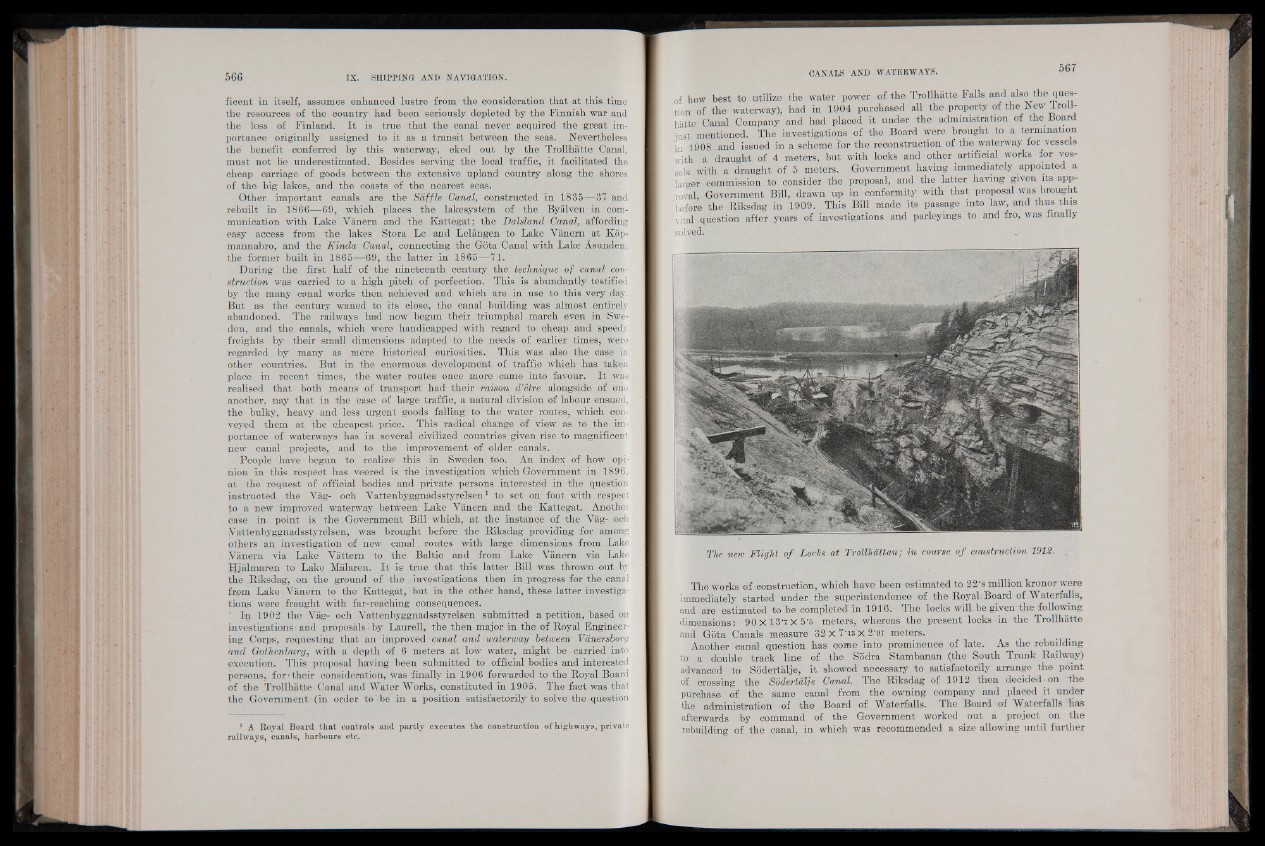
ficent in itself, assumes enhanced lustre from the consideration that at this time
the resources of the country had been seriously depleted by the Finnish war and
the loss of Finland. I t is true that the canal never acquired the great importance
originally assigned to it as a transit between the seas. Nevertheless
the benefit conferred by this waterway, eked out by the Trollhatte Oanal,
must not be underestimated. Besides serving the local traffic, it facilitated the
cheap carriage of goods between the extensive upland country along the shores
of the big lakes, and the coasts of the nearest seas.
Other important canals are the Baffle Canal, constructed in 1835—37 and
rebuilt in 1866—69, which places the lakesystem of the Byalven in communication
with Lake Vanern and the Kattegat; the Dalsland Canal, affording
easy access from the lakes Stora Le and Lelangen to Lake Vanern at Kop-
mannabro, and the Kinda Canal, connecting the Gota Oanal with Lake Asunden,
the former built in 1865—69, the latter in 1865—-71. .
During the first half of the nineteenth century the' technique of canal construction
was carried to a high pitch of perfection. This is abundantly- testified
by the many canal works then achieved and which are in use to this very day.
But as the century waned to its close, the canal building was almost entirely
abandoned. The railways had now begun their triumphal march even in Sweden,
and the canals, which were handicapped with regard to cheap and speedy
freights by their small dimensions adapted to the needs of earlier times, were
regarded by many as mere historical curiosities. This was also the case in
other countries. But in the enormous development of traffic which has takten
place in recent times, the water routes once more came into favour. It:.was
realised that both means of transport had their raison d’efreValongside of one
another, nay th a t in the case of large traffic, a natural division of labour ensued,
the bulky, heavy and less urgent goods falling to the water routes, which conveyed
them at the cheapest price. This radical change of view as to the importance
of waterways has in several civilized countries given rise to magnificent
new canal projects, and to the improvement of older canals.
People have begun to realize' this in Sweden too. An index of how opinion
in this respect has veered is the investigation which Government in 1896,
at the request of official bodies and private persons interested in the question
instructed the Vag- och Vattenbyggnadsstyrelsen1 to set on foot with respect
to a new improved waterway between Lake Vanern and the Kattegat. Anothei
case in point is the Government Bill which, at the instance of the Vagi och
Vattenbyggnadsstyrelsen, was brought before the Riksdag providing for among
others an investigation of new canal routes with large dimensions from Lake
Vanern via Lake Vattem to the Baltic and from Lake Vanern via Lake
Hjalmaren to Lake Malaren. I t is true th a t this latter Bill was thrown out by
the .Riksdag, on the ground of the investigations then in progress for the canal
from Lake Vanern to the Kattegat,' but in the other hand, these latter investigations
were fraught with far-reaching consequences.
1 In 1902 the Vag- och Vattenbyggnadsstyrelsen submitted a petition, based on
investigations and proposals i by Laurell, the then major in the of Royal Engineering
Corps, requesting that an improved - canal and ■ waterway between Vdnersborg
and Gothenburg, with a depth of 6 meters at low water, might be carried into
execution. This proposal having been submitted to official bodies and interested
persons, for>their consideration, was finally in 1906 forwarded to the Royal Board
of the Trollhatte. Canal and Water Works, constituted in 1905. The fact was that
the Government1 (in order to ' be in a position satisfactorily to solve the question
1 A Royal Board that controls and partly executes the construction of highways, private
railways, canals, harbours etc.
of how best to utilize the water power of the Trollhatte Falls and also the question
of the waterway), had in 1904 purchased all the property of the New lroll-
hatte Oanal Company and had placed it under the administration of the Board
just mentioned. The investigations of the Board were brought to a termination
in 1908 and issued in a scheme for the reconstruction of the waterway for vessels
with a draught of 4 meters, but with locks and other artificial works for vessels
with a draught of 5 meters. Government having immediately appointed a
larger commission to consider the proposal, and the latter having given its approval
Government Bill, drawn up in conformity with th a t proposal was brought
before the Riksdag in 1909. This Bill made its passage into law, and thus this
vital question after years of investigations and parleyings to and fro, was finally
solved1. _
The new Flight o f Locks at Trollhättan; in course o f construction 1912.
The works of construction, which have been estimated to 22'8 million kronor were
immediately started under the superintendence of the Royal.Board of .Waterfalls,
and are estimated to be completed in 1916. The locks will be given the following
dimensions: 9 0X l3 '7X 5 '6 meters, whereas the present locks in the Trollhatte
and Gota Canals measure 32 X 7"i3 X 2'97 meters.
Another canal question has come into prominence of late. As the rebuilding
to a double track line of the Sodra Stambanan (the South Trunk Railway)
advanced to Sodertalje, it showed necessary to satisfactorily arrange the point
of crossing the Sodertalje Canal. The Riksdag of 1912 then decided * on the
purchase of the same canal from the owning company and placed it under
the administration of the Board of Waterfalls. The Board of Waterfalls has
afterwards by command of the Government worked out a project on the
rebuilding of the canal, in which was recommended a size allowing until further